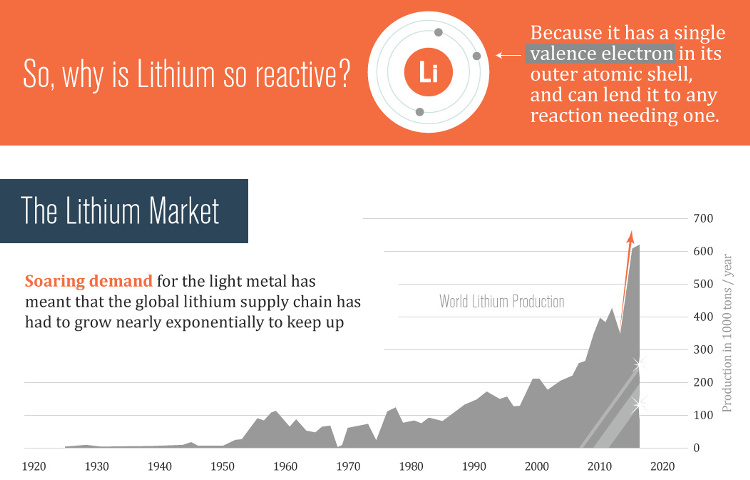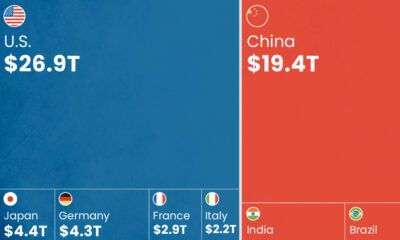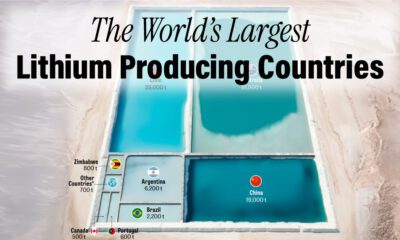Energy
Lithium: The Key Ingredient Powering Today’s Technology

Lithium: The Key Ingredient Powering Today’s Technology
Lithium infographic presented by: Dajin Resources
Lithium is nature’s lightest metal, but it is also one of the most chemically reactive, which makes it a key ingredient in powering and building the latest technology.
Most similar to a material such as wood in density, lithium would float on water if it didn’t react with it so intensely. The light metal even reacts with air almost instantly, turning from a silvery-white to dark grey.
Why is lithium so reactive? It is because it has a single valence electron that it can lend to many different types of chemical reactions.
Before 1990, it was rare for more than 100,000 tonnes of lithium to be used each year. However, since then demand has skyrocketed to closer to 600,000 tonnes per year, where it is today. Lithium’s uses are split between chemical and technical, but the fastest growing segments of demand are derived from its electrochemical potential.
Lithium has the highest electric output per unit weight of any battery material, which makes it the obvious choice for energy storage in many types of technology. Electric cars, renewable energy, smart grids, and consumer electronics are all using lithium ion batteries, and these markets all show signs of growth in the future.
Furthermore, lithium has some other interesting uses as well. Recently Alcoa developed a 4th generation aluminum-lithium alloy to reduce weight of airliners. The result is a 15% fuel savings through increased fuel efficiency.
While lithium is not scarce, it does tend to be deposited in very low concentrations through many types of rocks. The biggest challenge is finding high enough concentrations to make it cost-efficient to produce. Uniquely to lithium, brine deposits can cut exploration and milling costs by up to 50%, which has priced many hard rock miners out of the market.
Brine deposits are produced mainly from salt flats, which are also known as salars. The “Lithium Triangle” is the major industrial producer of lithium and holds over 70% of global reserves. The only producing lithium mine in the United States is in Clayton Valley, Nevada in the “Lithium Hub”, which is very close to the site of Tesla’s $5 billion Gigafactory.
Lithium, because of its physical and chemical properties, is an essential ingredient powering today’s technology. Moving forward, lithium will be even more important for crucial areas such as power storage, electronics, automobiles, defense, and aerospace.
Related infographic: The Look and Feel of Canadian Venture Market Bottoms from 1981-2014
Energy
The World’s Biggest Nuclear Energy Producers
China has grown its nuclear capacity over the last decade, now ranking second on the list of top nuclear energy producers.

The World’s Biggest Nuclear Energy Producers
This was originally posted on our Voronoi app. Download the app for free on Apple or Android and discover incredible data-driven charts from a variety of trusted sources.
Scientists in South Korea recently broke a record in a nuclear fusion experiment. For 48 seconds, they sustained a temperature seven times that of the sun’s core.
But generating commercially viable energy from nuclear fusion still remains more science fiction than reality. Meanwhile, its more reliable sibling, nuclear fission, has been powering our world for many decades.
In this graphic, we visualized the top producers of nuclear energy by their share of the global total, measured in terawatt hours (TWh). Data for this was sourced from the Nuclear Energy Institute, last updated in August 2022.
Which Country Generates the Most Nuclear Energy?
Nuclear energy production in the U.S. is more than twice the amount produced by China (ranked second) and France (ranked third) put together. In total, the U.S. accounts for nearly 30% of global nuclear energy output.
However, nuclear power only accounts for one-fifth of America’s electricity supply. This is in contrast to France, which generates 60% of its electricity from nuclear plants.
| Rank | Country | Nuclear Energy Produced (TWh) | % of Total |
|---|---|---|---|
| 1 | 🇺🇸 U.S. | 772 | 29% |
| 2 | 🇨🇳 China | 383 | 14% |
| 3 | 🇫🇷 France | 363 | 14% |
| 4 | 🇷🇺 Russia | 208 | 8% |
| 5 | 🇰🇷 South Korea | 150 | 6% |
| 6 | 🇨🇦 Canada | 87 | 3% |
| 7 | 🇺🇦 Ukraine | 81 | 3% |
| 8 | 🇩🇪 Germany | 65 | 2% |
| 9 | 🇯🇵 Japan | 61 | 2% |
| 10 | 🇪🇸 Spain | 54 | 2% |
| 11 | 🇸🇪 Sweden | 51 | 2% |
| 12 | 🇧🇪 Belgium | 48 | 2% |
| 13 | 🇬🇧 UK | 42 | 2% |
| 14 | 🇮🇳 India | 40 | 2% |
| 15 | 🇨🇿 Czech Republic | 29 | 1% |
| N/A | 🌐 Other | 219 | 8% |
| N/A | 🌍 Total | 2,653 | 100% |
Another highlight is how China has rapidly grown its nuclear energy capabilities in the last decade. Between 2016 and 2021, for example, it increased its share of global nuclear energy output from less than 10% to more than 14%, overtaking France for second place.
On the opposite end, the UK’s share has slipped to 2% over the same time period.
Meanwhile, Ukraine has heavily relied on nuclear energy to power its grid. In March 2022, it lost access to its key Zaporizhzhia Nuclear Power Station after Russian forces wrested control of the facility. With six 1,000 MW reactors, the plant is one of the largest in Europe. It is currently not producing any power, and has been the site of recent drone attacks.
-

 Mining2 weeks ago
Mining2 weeks agoCharted: The Value Gap Between the Gold Price and Gold Miners
-

 Real Estate1 week ago
Real Estate1 week agoRanked: The Most Valuable Housing Markets in America
-

 Business1 week ago
Business1 week agoCharted: Big Four Market Share by S&P 500 Audits
-

 AI1 week ago
AI1 week agoThe Stock Performance of U.S. Chipmakers So Far in 2024
-

 Misc1 week ago
Misc1 week agoAlmost Every EV Stock is Down After Q1 2024
-

 Money2 weeks ago
Money2 weeks agoWhere Does One U.S. Tax Dollar Go?
-

 Green2 weeks ago
Green2 weeks agoRanked: Top Countries by Total Forest Loss Since 2001
-

 Real Estate2 weeks ago
Real Estate2 weeks agoVisualizing America’s Shortage of Affordable Homes

















